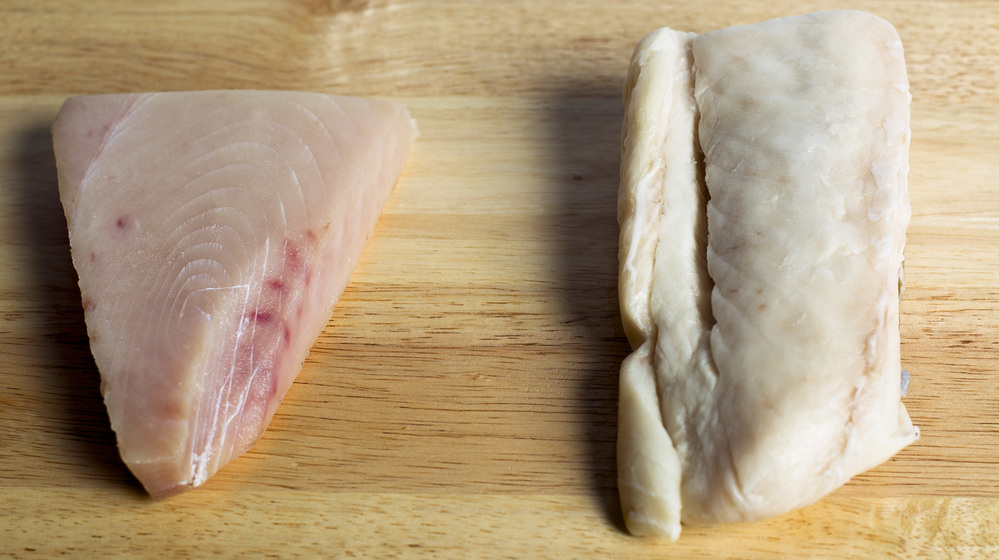 Enlarge image i
Enlarge image i Escolar, right, is often substituted for more expensive Albacore tuna (left), a report on mislabeled seafood found.

Escolar, right, is often substituted for more expensive Albacore tuna (left), a report on mislabeled seafood found.
There are so many fish in the sea. But from a diner's viewpoint, peering down at a sliver of white fish atop a bed of sushi rice, a lot of them look the same.
Now a report from the ocean conservation group Oceana confirms that there's a pretty decent chance that fish on the plate or on ice in the seafood case is not what it's labeled to be. That means that seafood wallet cards designed by conservation groups to help steer consumers towards sustainable choices may not be doing much good.
Between 2010 and 2012, Oceana took 1,215 seafood samples from 674 retail outlets in 21 states. When they tested the DNA, they found that 33 percent were mislabeled. Sushi vendors and grocery stores were the most likely outlets to sell mislabeled food, though Oceana says the fraud can happen before it reaches them.
Earlier investigations by Oceana and the Boston Globe revealed that seafood mislabeling is common in cities like New York and Boston, where people eat a lot of fish. But the report out Thursday shows it's happening across the country, and is as bad or worse in places like Texas and Colorado. Some 49 percent of the retail outlets sampled in Austin and Houston sold mislabeled seafood, while 36 percent in Colorado did so.
So what's the big deal with fish sold under a pseudonym? Well, for one, it's often just a form of swindling a cheap fish like tilapia sold as red snapper. But Oceana says the practice also can put consumers at health risk when species like king mackerel, which is high in mercury, or escolar, which contains a naturally occurring toxin than can cause gastrointestinal problems, are marketed as grouper and white tuna, respectively.
Oceana's also concerned that substituting cheaper, easier-to-find fish for rarer, more valuable ones gives consumers a distorted sense of the market. Of the fish types most heavily sampled by Oceana, those sold as snapper and tuna had the highest mislabeling rates 87 and 59 percent. Only seven of the 120 samples of red snapper purchased nationwide were actually red snapper, the report found.
"The majority of fraud is various fish standing in for snapper it's used as catch-all name for all kinds of white fleshed fish," says Oceana senior scientist Kimberly Warner. "But there are real conservation concerns when you slip in things in place of the real thing. People think snapper must be doing great because it's everywhere, but it's overfished."
Consumers using wallet cards from groups like the Monterey Bay Aquarium and NRDC could end up buying exactly the species they're trying to avoid, Warner says, because mislabeling is so prevalent.
One reason mislabeling has gotten so rampant is that the U.S. now imports 90 percent of its seafood and less than 2 percent is inspected for fraud. That means would-be fraudsters have a lot new options for substitutions.The Food and Drug Administration regularly updates its list of seafood approved for sale in 2012 alone, 19 new species were added to the list, including cornetfish, sampa and claresse.
So what's the government or a consumer to do about all this? Oceana would like to see an international traceability system where retailers would be required to tell consumers where and when a fish was caught and what gear was used. Requirements like these would help the industry one of the least transparent in the food system more accountable.
The National Fisheries Institute argues that the problem is one of enforcement the FDA needs to do a better job of enforcing laws that are already on the books to discourage fraud. And they encourage consumers to seek out retailers through the Better Seafood Board.
Oceana targets fishy labeling practices - SFGate The braised chunk of fish labeled "Local Halibut Filet" at a posh San Francisco restaurant where a group of food sleuths were eating looked appetizing, but the first ... Target.com : Furniture, Baby, Electronics, Toys Expect more pay less with Target. Spend $50, get free shipping on over 500K items. Choose from a wide selection of furniture, baby, electronics, toys, shoes, c Grocery, restaurant labeling of fish is, well, fishy, study finds NEW YORK - Nearly three in five New York City grocery stores and restaurants that sell seafood have mislabeled part of their stock, substituting varieties that could ... Investigation Uncovers Rampant Fish Fraud - ABC News A new investigation provides fresh evidence that restaurants and markets continue to dupe seafood lovers into paying top dollar for low-grade fish. As part ... Mislabeled Fish Common In New York Restaurants, Markets: Study Don't order the white tuna. That's one big takeaway from the latest major study of fish fraud, this one conducted in New York City by marine conservation ... Fish sold in New York is routinely mislabeled: study - Yahoo! News NEW YORK (Reuters) - Nearly three in five New York City grocery stores and restaurants that sell seafood have mislabeled part of their stock, substituting ... Fish sold in New York is routinely mislabeled, study finds Nearly three in five New York City grocery stores and restaurants that sell seafood have mislabeled part of their stock, substituting varieties that could ... Widespread Seafood Fraud Found in New York City 1 Widespread Seafood Fraud Found in New York City December 2012 Authors: Kimberly Warner, Ph.D., Walker Timme and Beth Lowell Executive Summary
No comments:
Post a Comment